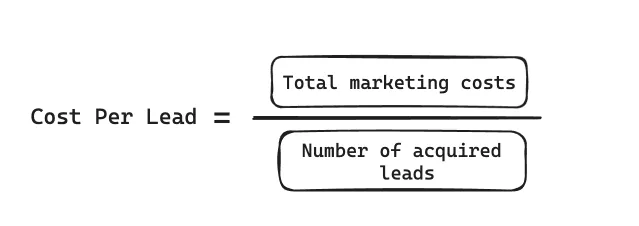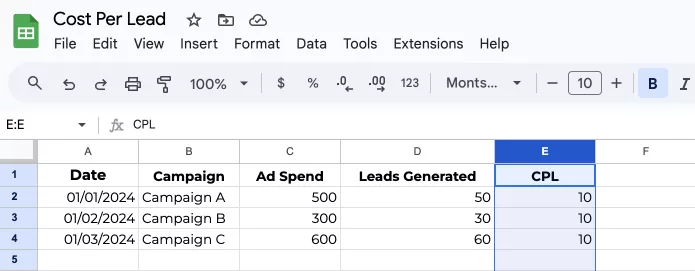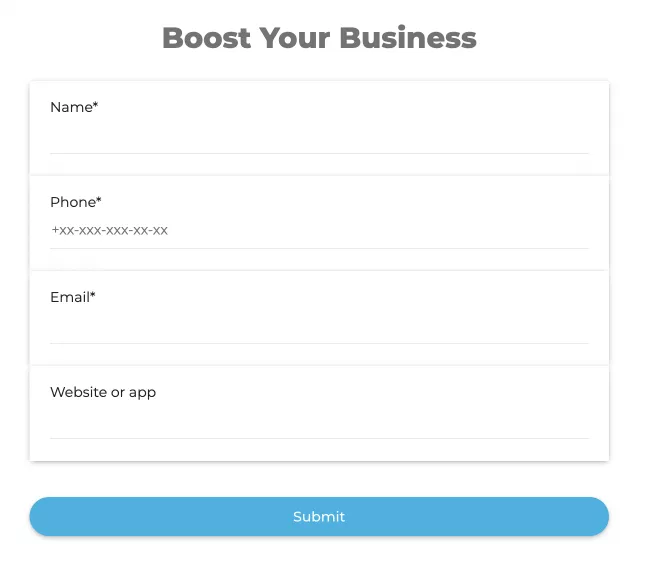Cost Per Lead (CPL) helps us understand how much it costs to attract potential customers. This metric is used to evaluate the effectiveness of lead generation efforts. In this article, I will explain how to calculate CPL, why it is important, and what is considered good CPL.
What is Cost Per Lead?
CPL is an indicator that measures the cost of acquiring a potential customer (lead) through digital marketing campaigns. A lead is a person who is interested in a product and has left their contact information or otherwise shown that they are considering a purchase, such as by subscribing to the company's email newsletter.
How to calculate Cost Per Lead (CPL)
The formula looks like this:
- Total marketing costs include all monetary investments related to a marketing campaign, such as agency fees, content creation, advertising, and software.
- Number of acquired leads is the total number of potential customers received as a result of a marketing campaign.
For example, if a company spent $3000 on advertising and generated 150 leads:
CPL = $3000/150 = $20
The importance of CPL in digital marketing
Understanding and using CPL data allows marketers to make informed decisions, improve strategies, and achieve better results.
By calculating CPL, companies can
- determine how much it costs to acquire each potential customer;
- allocate marketing budgets more efficiently, ensuring that resources are used where they generate the greatest return on investment.
If one ad campaign has a CPL of $10 and another has a CPL of $50, the company should invest in the lower-priced ad, provided that the quality of the leads is the same.
Also, companies can use CPL data from previous periods to predict the budget and set realistic goals for lead generation.
If the average price per lead over the past year was $25, budgeting for a new campaign to generate 1000 leads involves allocating about $25,000.
CPL vs. CAC
Cost Per Lead and Customer Acquisition Cost are complementary metrics. When used together, they provide valuable insights into the various stages of the customer acquisition process.
Cost Per Lead (CPL) measures the cost of acquiring a potential customer through marketing campaigns. It focuses on the early stage of the customer journey when a person shows initial interest but has not yet made a purchase.
Customer Acquisition Cost (CAC) gives an idea of how much it costs to convert a potential customer into an actual one. The focus is on the cost of customer acquisition, from lead generation to the final sale. This metric is calculated using the formula:
CAC is usually higher because it includes costs that go beyond lead generation, such as sales efforts and after-sales support.
What is a good Cost Per Lead?
A good Cost Per Lead varies greatly depending on the industry, business size, marketing channels, and lead quality. Here are the factors that influence the definition of a good CPL.
- Lead quality. Leads that are more likely to convert into paying customers justify a higher CPL. For example, a B2B software company should agree to a higher CPL if the potential customers are senior executives with decision-making authority.
- Customer lifetime value (CLV). Companies with a higher CLV can spend more money on attracting potential customers. For example, a luxury car dealership will have a higher CPL than a fast food restaurant because a luxury car customer has a higher lifetime value.
- Conversion rate. A higher conversion rate from lead to customer actually justifies a higher CPL. For example, if 20% of leads convert to customers, a higher CPL is more acceptable than a business with a conversion rate of only 5%.
- Marketing channels. Different channels will have very different CPLs.
Case study: Netpeak specialists helped set up advertising for the construction company Kovalska Real Estate. At first, they used classic tools:
- general and branded search advertising campaigns;
- contextual media network remarketing;
- media and video campaigns to attract new users.
For this client, 73.85% of potential customers came from search advertising. Scaling the results was necessary, but due to high competition at the auction, this could increase the Cost Per Lead. Therefore, the specialists decided to test a smart campaign on the display network with a pay-per-conversion approach.
Results: The number of leads increased by 36.52%, while their cost decreased by 46%.
KPIs for Cost Per Lead
By setting KPIs related to cost per lead (CPL), companies can measure the effectiveness and efficiency of their efforts. Here are some examples of such CPLs in different contexts:
- Measure the average cost of generating a lead across all marketing channels.
- Determine the CPLs of individual marketing channels to determine the most profitable ones. For example, compare the effectiveness of Google Ads, Facebook ads, email marketing, and organic search.
- Evaluate the CPLs of specific marketing campaigns to determine the effectiveness of each one.
- Track changes over time to identify trends and areas for improvement. For example, let’s say the January CPL is $45, the February CPL is $40, and the March CPL is $38. This decrease in price indicates that the marketing efforts are becoming more effective.
- Measure CPL for different audience segments to identify the most profitable target groups.
Where to find CPL benchmarks
To find out the estimated CPL for your industry, use one of the following sources:
- WordStream's Google Ads Benchmarks reports provide detailed CPL data for various industries based on its huge database.
- HubSpot's State of Inbound reports often include CPL metrics.
- The Statista platform offers a variety of statistics, including CPLs for various industries.
- The MarketingProfs website publishes articles and research on marketing trends, including CPL indicators.
- Content Marketing Institute authors often publish industry-specific metrics in their reports and articles.
How to monitor Cost Per Lead
CPL monitoring involves tracking the costs associated with lead generation and analyzing them to optimize marketing strategies.
The easiest way to do this is to create a Google Spreadsheet to keep track of your calculations.
- Enter or import the data for each campaign: Date, Campaign name, Ad Spend, Leads generated, and Cost Per Lead (CPL).
- Click on the first cell in the CPL column (for example, E2) and enter the formula: =C2/D2. This will divide the ad spend by the number of leads generated for that row.
- Drag the fill handle (the small square in the lower right corner of the selected cell) down the CPL column to apply the formula to the remaining rows.
You can also use a pre-made template.
There are also other methods of tracking CPL:
- Use marketing analytics tools:
- Google Analytics can track website traffic and user behavior.
- CRM systems, such as Salesforce, will manage leads throughout the sales funnel and measure lead quality and conversion rates.
- Advertising platforms such as Google Ads and Facebook Ads use built-in reporting features to calculate the CPL for each campaign.
- Combine data from CRM, Google Analytics, and ad platforms using tools like Looker Studio. This will help you easily compare CPLs across channels and campaigns.
- Track the budget spent on each marketing channel and campaign. A useful tool for this purpose is QuickBooks.
- Calculate CPLs regularly, such as weekly or monthly, to track performance and identify trends. Use tools with automated scripts like Tableau to create regular CPL reports.
Best practices to improve your Cost Per Lead
Improving your cost per lead (CPL) involves optimizing various aspects of your marketing strategy to generate high-quality leads at a lower cost.
- Improve your targeting. Segment your audience by demographics, behavior, and interests to target the most relevant groups. Use similar audiences on the Facebook Ads platform to find potential customers who are similar to your best existing customers.
- Optimize your ad campaigns. Constantly test different ad creatives, headlines, and calls-to-action to determine the most effective combinations. Run ads when your target audience is most active. Use automated bidding strategies, such as Google Ads Target CPA, to optimize conversions within your budget.
- Improve lead quality. Use forms with clarifying questions to filter out less interested or irrelevant leads.
Conclusions
- CPL is a metric that measures the cost of acquiring a new lead. It is calculated by dividing the total marketing spend by the number of generated leads.
- Cost Per Lead (CPL) and Customer Acquisition Cost (CAC) are complementary metrics. CPL focuses on the cost of acquiring leads, while CAC takes into account all costs associated with customer acquisition.
- The CPL score is worth measuring. This metric helps marketers measure the effectiveness of their lead-generation efforts.
- A good CPL score depends on the industry and target audience. It should be evaluated in the context of lead quality and the potential lifetime value of the leads.
- Best practices for improving CPL include using audience segmentation and similar audiences for more accurate targeting, implementing A/B testing, doing ad planning, and using automated bidding strategies.
- It is important to regularly track CPLs with analytics tools and CRM systems. Changes in CPL will show you if your marketing efforts are working.
- Industry-specific CPL metrics will allow you to evaluate performance and set realistic goals. Sources for such indicators include industry reports, digital advertising platforms, and marketing publications.
Recommended theme posts
Related Articles
ChatGPT-5: How It May Affect AI SEO
Uncover how ChatGPT 5 will flip your SEO strategy over and reveal the ways to boost your online presence using it.
Amazon Global Advertising Prep: Why Does Cultural Fit Matter?
Unveil the perks of global advertising on Amazon and tips on how you should adapt your marketing approach to the customers from different countries.
Automatic Analysis of Customer Data (RFM Analysis) Using Google BigQuery
This article discusses how RFM analysis helps businesses identify their most valuable users, optimize their resources, retain existing customers, and attract new ones







